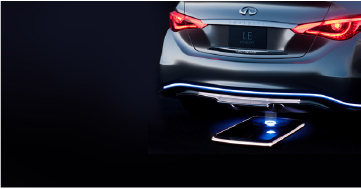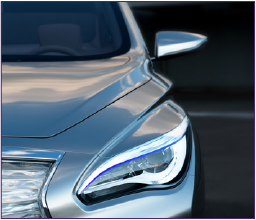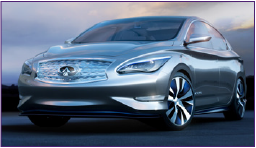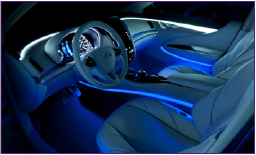
The LE will have the ability to charge wirelessly, using an inductive charger.

Infiniti will help move electric vehicles to market with the introduction of the LE Concept, a battery-powered mid-size luxury sedan. The Infiniti LE luxury EV rolls on the same wheelbase as the Nissan LEAF® economy car, but is stretched longer and wider for additional cabin space.

The zoomy LE concept represents an “85 percent” accurate view of the coming production model, which will arrive in less than 24 months, according to Nissan CEO Carlos Ghosn.
The LE Concept promises exciting styling with authentic luxury appointments that will attract the high-demographic buyers who are choosing electric vehicles today. While luxury appointments aren’t necessarily the cutting edge of engineering, adding these amenities can make new EV technology more appealing to customers who are willing to pay for them, which could solidify early EV demand. The LE Concept promises exciting styling with authentic luxury appointments that will attract the high-demographic buyers who are choosing electric vehicles today, observed Andy Palmer, executive vice president of Global Planning for Nissan.

From the sculpted headlights to the signature grille and crescent c-pillar, the Infiniti LE Concept is the culmination of bold design and organic movement.
Although Palmer promises “Infiniti performance” from the LE Concept, under its stylish skin lies some familiar hardware. Basic parts like the 24 kW•h lithium-ion battery pack, the electric motor, and the CHAdeMO (a Japanese quick-charging standard) battery charger seen on the LEAF® are all carried over to the LE Concept, reported Chikuya Takada, chief product specialist for the LE Concept.
The chassis is also very similar to the LEAF’s with front strut suspension and a rear torsion beam arrangement mounted on the same 106.3-in (2700 mm) wheelbase. Despite the apparently common underpinnings, at 186.4 in (4735 mm), the LE is nearly a foot longer and it is 1.4 in (36 mm) wider for cabin space on par with Infiniti’s G models.

The interior design captures the movement of nature, with sculpted seats designed to contour to your body. The sweeping curved cabin surrounds passengers in bold waves.
Some of the promised “Infiniti performance” will come in the form of improved acceleration, though Takada wouldn’t specify exactly how the same 100-kW, 240-lb•ft (325 N•m) electric motor and 24 kW•h battery pack would yield that faster acceleration. He did say that the software is being optimized to increase regeneration under deceleration, which would offset any reduction in range that results from the performance upgrades, preserving the same driving range as in the LEAF®.
A lower 0.25 coefficient of drag, compared to the LEAF’s 0.29, will improve the LE’s highway efficiency and help to preserve the same driving range even with enhanced performance. Another contributor will be an upgraded power inverter, Takada added.
In total, the driving experience will provide both the speed premium customers expect and the smoothness for which electric drive is known, he said. “Luxury buyers really appreciate the feeling of smooth, powerful torque from the beginning,” Takada said.
Another new feature will be the ability to charge the LE wirelessly using an inductive charging mat in their garage floor. The company predicts that its Wireless Charging System will be the first commercially available wireless inductive charger when it comes to market with the car in two years.
Not only is the charging no-touch, so is the parking. The LE Concept’s Intelligent Park Assist system guides the car into parking spaces and automatically aligns it with the charging mat, so drivers needn’t worry whether the car is correctly positioned over its charger. The system will use Nissan’s 360-degree Around View monitor system to guide the car’s steering.